Too Hot to Learn
Air Date: Week of September 8, 2023
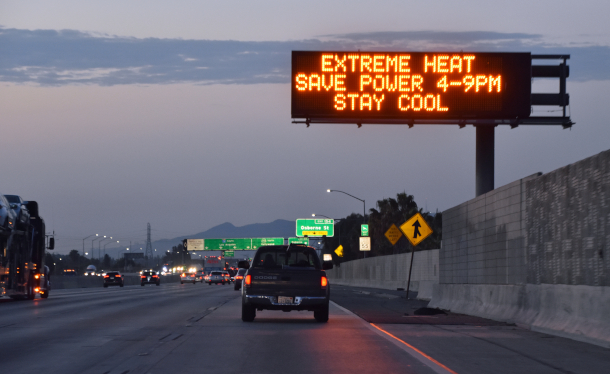
Extreme heat can affect us in subtle ways, impairing our cognitive abilities and reaction time. (Photo: Chris Yarzab, Flickr, CC BY 2.0)
As extreme heat linked to climate disruption becomes more common during the school year, many U.S. schools lack adequate cooling and ventilation systems to keep kids safe and focused on learning. Dr. Joseph Allen, an Associate Professor and Director of the Healthy Buildings Program at the Harvard TH Chan School of Public Health, joins Host Paloma Beltran to explain how temperature and air quality affect learning outcomes for low-income kids and students of color the most.
Transcript
DOERING: From PRX and the Jennifer and Ted Stanley Studios at the University of Massachusetts, Boston this is Living on Earth. I’m Jenni Doering.
BELTRAN: And I’m Paloma Beltran.
Kids are back in school in the U.S., which may feel like the ninth circle of hell for some of them, and not just because of the homework and tests. With extreme heat still baking the country, many schools aren’t prepared for the effects of the climate crisis, leaving students and teachers with no other choice than to work inside sweltering buildings. In 2020, the Government Accountability Office estimated that around 36,000 schools in the US needed to update or replace their heating, ventilation and air conditioning, or HVAC systems. Many of those schools don’t have AC at all. Here to tell us what that means for kids and teachers is Dr. Joseph Allen, an Associate Professor and Director of the Healthy Buildings Program at the Harvard TH Chan School of Public Health. Dr. Allen, welcome back to Living on Earth!
ALLEN: It's great to be on again. Thanks for having me.
BELTRAN: So talk to me about what happens to humans when the temperature climbs, and how do these health effects play out in academic settings?
ALLEN: Well, I mean, I think there's been a lot written this summer, in particular, because of all the heat waves we've had, around the health effects associated with extreme heat, everything from heat exhaustion, heat stress. I think what we tend to focus less on are the more subtle impacts, and particularly around what happens to kids in school, or anybody in school for that matter, including teachers. So this is not the kind of heat exhaustion where someone is going to collapse, or needs to be rushed to the hospital, has to be cooled down rapidly. But this is just what heat is doing to us while we're inside, even in conditions that are tolerable, right, to the body, that we think are tolerable. We think we're compensating, but study after study shows that it's having an impact on our ability to concentrate and perform and think clearly.
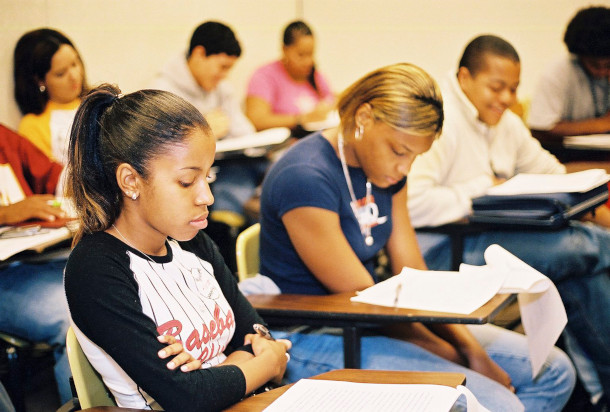
According to a study from Harvard University, students are 12% more likely to fail a test on a 90-degree day versus a 72-degree day. (Photo: US Department of Education, Flickr, CC BY 2.0)
BELTRAN: So what are some of those subtle effects? Can you tell me about a few of the studies here?
ALLEN: So in schools, there are studies that have measured indoor temperature and test scores, for example. And a really important one was one done in New York State, where they followed students for 10 years of test data. And it turns out that students were 12% more likely to fail a test if it was a 90 degree day versus a 72 degree day. And I think that's really interesting, one as a parent of three kids myself, but also as a public health researcher, and thinking about all the things we do for academic achievement, and it turns out temperature on the day of the test is going to have this impact on test scores. And this is something we see across every age group. We see similar results for workers, where we see worse performance on memory tests. We've done studies of university students showing that in higher temperatures during a heatwave, their reaction times on these cognitive tests decline. So it's really consistent in the sense that across every study, every age group, we see the impacts of heat in situations where people probably don't even know it's having that effect.
BELTRAN: Yeah, you know, how might short term learning outcomes affect long term education outcomes for the students, when we're talking about heat?
ALLEN: Well, you know, for example, SAT scores, well, if you're more likely to fail that test, and that's a standardized test that helps you get into college, well certainly then, the heat on the day of the test has influenced your long term prospects. I think another aspect of this when there's extreme heat, that's not just about your ability to concentrate, but also about whether or not you're in the school. And if you look at what has happened, as the climate changes, and the heat waves start earlier, and end later, we're starting to have conditions where schools are closed due to extreme heat. It's not just they're gonna perform worse when it's hot when they take a test. They're not even in the school.
BELTRAN: Wow.
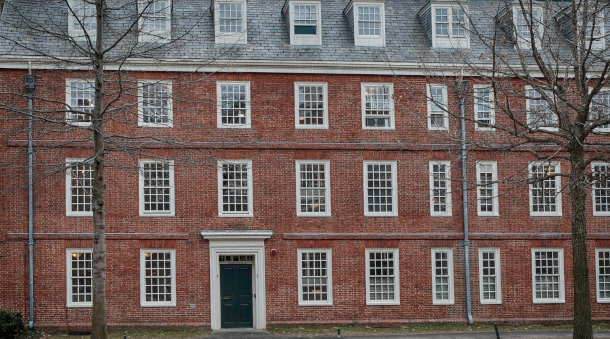
Many school buildings in northern climates are designed to retain heat. This makes them particularly underprepared for heat waves exacerbated by climate change. (Photo: Jonathan E Shaw, Flickr, CC BY-NC 2.0)
ALLEN: I wrote about this in the Washington Post last year, where we had school closures in May, in places like Philadelphia, New York City, Washington, DC, Boston. I grew up in the northeast. We never had school closures due to heat, even in June. So you have like the direct impacts of extreme heat on learning and cognitive function. And then you have these, what's called indirect effects where the students are missing additional school days, because the building just can't handle the temperatures, right? The teachers, the students, the staff, can't be in the building. So this is interesting, too, because it becomes an equity issue. Because what do you do on an extreme heat day? You let some kids stay in schools, the schools that have air conditioning, and the kids in schools without air conditioning, you send home? That doesn't seem right. And not only is it not right, it should be totally unacceptable. So extreme heat's changing, or should be changing a lot of people's minds about how we think about the role of the school building and buildings in general, on well being.
BELTRAN: So there's different outcomes for different geographical areas here.
ALLEN: Yeah, that's really important, because in a lot of these conversations I've been having this summer with the heat waves, we need cooling in our buildings and our schools. And the reality is that a lot of the South already has this. A bigger issue, even though the temperatures don't get as high, is what's happening in places that are traditionally cold weather climates, like the northeast, like in the Pacific Northwest, in Seattle. Very few buildings have air conditioning, they haven't had a need for it. And in fact, the buildings, many buildings in these climates were designed to retain heat. Think about schools where I'm in Boston. They're designed to retain heat, because most of the time, we need to heat these schools, and we're protecting against the cold. And now you have these buildings that don't have the ability to cool, the building materials actually absorb and retain heat. And it's a recipe for a problem that we haven't had to face. And because of climate change, we're facing it, it's acute, and it's only going to get worse.
BELTRAN: Yeah, I mean, extreme heat, which as you mentioned right now, will only get more extreme as the climate crisis continues, that's a major challenge. But it's not the only one. How does extreme heat intersect with other environmental issues? I'm thinking, air pollution and wildfire smoke.
ALLEN: Yeah, this has been a source of frustration for me, because what I see out there a lot is that we're treating these crises in different silos. In June, on the east coast, we were, everyone's focused on wildfire smoke. In the middle of the summer, everyone's talking about extreme heat. Then we're talking about COVID. And the conversation starts to hit, you know, these cycles of panic and neglect. And the reality is that all of these crises run through our buildings, and they're related. So if you make improvements to the building systems that help with COVID, specifically improving ventilation and filtration, well, that's going to help against wildfire smoke, which is an outdoor pollution problem. But it becomes an indoor problem as that starts to seep into our buildings. Same thing with extreme heat. The problem runs through our buildings, the solutions run through our buildings, right? If you if you have a high performing building, then wildfire smoke is not a threat, then extreme heat is not a threat. And COVID, influenza, RSV, other respiratory pathogens, are a much lower threat.
BELTRAN: And what do we know about CO2 levels in classrooms? And how does it connect to ventilation?
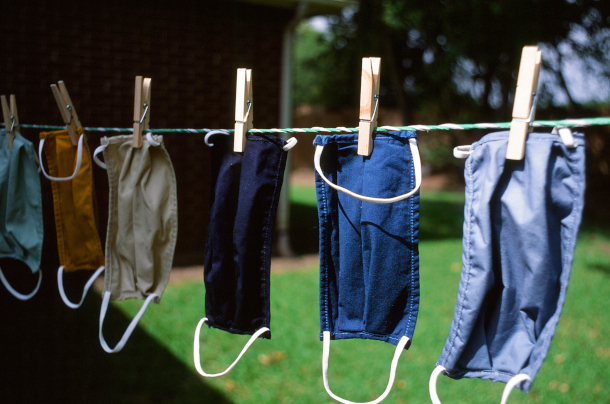
Dr. Allen says school building designs should simultaneously address the threats of respiratory infections, outdoor air pollution, and extreme heat. (Photo: Chris Zuniga, Flickr, CC BY-NC 2.0)
ALLEN: So when you design a building, there are standards for how much outdoor air should come in, right? We've talked about ventilation, how much outdoor air is coming into the space. Based on the number of people in the space, the size of space, and those rates of air coming in, that will determine the CO2 level, the carbon dioxide level, because humans are the main source of carbon dioxide indoors. And so carbon dioxide levels are related to ventilation, but we regulate or set standards for ventilation rates. Couple problems. The current standards for schools are bare minimums, not designed for health. It's the standard for quote unquote, "acceptable" indoor air quality. Not good, not healthy, not optimal, just acceptable. A bare minimum. So we design our schools for these low ventilation rates that are well below what the science says we should be doing. And then they drop in performance over time if they're not maintained very well. So you can actually use carbon dioxide as an indicator of that ventilation rate. Now, that said, there are some efforts, including some underway in New York City, to set requirements for monitoring carbon dioxide, which is a great indicator for ventilation. To me, that would go a long way. Because it's the classic business maxim, you can't manage what you don't measure. We haven't been measuring indoor air quality. Boston Public Schools, where I am, deployed real time indoor air quality sensors with carbon dioxide monitoring in all their schools. Parents can look up the data about their kid's classroom, a teacher can look up about the classroom. And I think it should be standard in schools across the country to measure it, because then we can't hide from the problem. It's one thing, it's pretty, you can be pretty hand wavy about it and say, oh, yeah, we have indoor air quality and ventilation under control. It's another thing to have someone monitor in that space, and objectively determine, is this space performing as it should? How are you actually going to know if it's meeting the new CDC target, let's say, of 800 parts per million of carbon dioxide? The only way to know is to measure. So we should be measuring and monitoring. We also need to lift those baseline standards from these acceptable minimums up to true health based targets.
BELTRAN: To what extent is this issue disproportionately affecting students of color and low income students?
ALLEN: Well, like much of what we see in society, and much of what COVID revealed, the disparities are wide when it comes to school buildings and the indoor air and indoor environmental quality. Take, for example, ventilation rates. So we know that all schools are not designed to the appropriate health based targets. But we also know that schools where the majority of kids are Black or Hispanic, have even lower ventilation rates on average. And in schools where the higher proportion of students are on free or reduced lunch, so lower income communities, we also see even lower ventilation rates. So it's truly appalling, the state of our schools, the state of some of our schools, that we've let them slide so far that even these, these well known hazards are not addressed. This is one of the big issues with this topic. We shouldn't even be having this conversation. It is totally unacceptable that we would have kids in a learning environment that was not safe, comfortable and healthy. It's not too much to ask for a building that isn't 80 or 90 degrees where a student can learn. It's not that much to ask to have a building that prevents outdoor pollution from penetrating inside. It's not that much to ask to have a school building with ventilation and filtration that protects against respiratory pathogens. We know exactly what to do, the money is there, the threat is known. And yet we haven't done it. We've neglected our buildings and our school buildings in particular, for decades upon decades. It should be totally unacceptable.
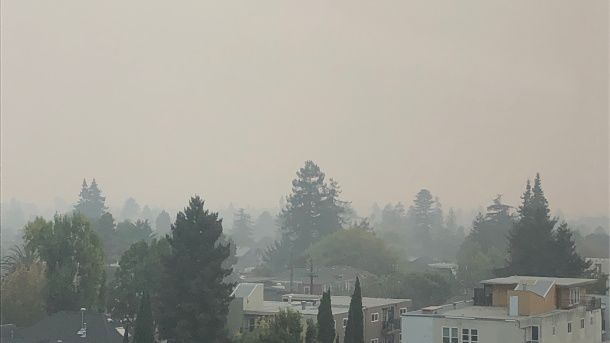
On average, schools with higher proportions of students of color and low-income students have lower ventilation rates. (Photo: Melinda Young Stuart, Flickr, CC BY-NC-ND 2.0)
BELTRAN: So you mentioned that the money is already there to make these changes. So what kind of federal funding is available for schools to implement some of these strategies?
ALLEN: Well, the best source of funds right now is still the remaining pandemic funds, which can still be spent on improving the school building. They're COVID related, but it goes well beyond that. The changes you make to ventilation and filtration address the extreme heat issue, address the air pollution issue. The funding can be used for things like indoor air quality monitoring. You can give your building a tune up, a process we call commissioning, which is a great step. It saves energy and also improves indoor air quality. It's like giving a tune up to a car. So there's actually a lot you can do. And the money that's sitting on the table is still out there and available through the pandemic relief funds.
BELTRAN: What can people do here, listeners that are concerned about air quality in their schools, ventilation? What can they do?
ALLEN: I think first thing people can do is just start talking about it a bit more, right? The way things get done is you start to socialize it, and then demand it, and you start asking questions. What have we done to improve ventilation? Are we meeting the new CDC targets for carbon dioxide indoors? So I think the first part is start asking it, I'd start to demand monitoring and disclosure. Because I think that's when real change can happen, because there's some data to point to. There's also some tools we built if people are, you know, on to that next phase. So you can go to the Harvard Healthy Buildings Program website, we built a tool that helps you set a carbon dioxide level for a classroom. A teacher can do this, a parent can do this, to say, you know, what, if we're measuring, what level is acceptable, and what's unacceptable? We built a little tool to help you think about a portable air cleaner in the space, how to size it right. So it's great for wildfire smoke, great for COVID, great for influenza, but I think most important, we just have to keep talking about it, make sure that the school building isn't an afterthought.
BELTRAN: Dr. Joseph Allen is an Associate Professor of Exposure Assessment Science at the Harvard T.H. Chan School of Public Health. He's also the Director of the Harvard Healthy Buildings Program. Thank you so much for joining us.
ALLEN: Thanks for having me on. It's my pleasure.
Links
Harvard T.H. Chan School of Public Health | “Healthy Buildings Program”
Harvard University | “Temperature, Test Scores, and Human Capital Production”
Living on Earth wants to hear from you!
Living on Earth
62 Calef Highway, Suite 212
Lee, NH 03861
Telephone: 617-287-4121
E-mail: comments@loe.org
Newsletter [Click here]
Donate to Living on Earth!
Living on Earth is an independent media program and relies entirely on contributions from listeners and institutions supporting public service. Please donate now to preserve an independent environmental voice.
NewsletterLiving on Earth offers a weekly delivery of the show's rundown to your mailbox. Sign up for our newsletter today!
 Sailors For The Sea: Be the change you want to sea.
Sailors For The Sea: Be the change you want to sea.
 The Grantham Foundation for the Protection of the Environment: Committed to protecting and improving the health of the global environment.
The Grantham Foundation for the Protection of the Environment: Committed to protecting and improving the health of the global environment.
 Contribute to Living on Earth and receive, as our gift to you, an archival print of one of Mark Seth Lender's extraordinary wildlife photographs. Follow the link to see Mark's current collection of photographs.
Contribute to Living on Earth and receive, as our gift to you, an archival print of one of Mark Seth Lender's extraordinary wildlife photographs. Follow the link to see Mark's current collection of photographs.
 Buy a signed copy of Mark Seth Lender's book Smeagull the Seagull & support Living on Earth
Buy a signed copy of Mark Seth Lender's book Smeagull the Seagull & support Living on Earth

